Kathmandu, Nepal's capital, is a vibrant, noisy city. Packed full of history, palaces and temples, it is also within touching distance of Nepal's premier attraction, the Himalaya. Kathmandu is home to gems such as Durbar Square (with temples dating back to the 12th century), Boudhanath Stupa (a world heritage site), the Pashupatinath Temple (the country's most important Hindu temple, on the banks of the Bagmati river), and the Royal Palace (the site of the infamous 2001 massacre of the Royal Family by the then Crown Prince, and now converted into the Narayanhiti Palace Museum).
Kathmandu is also the gateway to the rest of Nepal—in particular the tranquil Bhaktapur, temple-tastic Patan, the Chitwan National Park, and, of course, the Himalaya (half of the world's 8000-metre peaks are found in Nepal). The mountains hold a magnetic attraction for many who visit Nepal. The trek to Everest base camp, a two-week trip starting with a nerve-racking flight to Lukla airport, is the most popular mountain activity, whilst the stunningly beautiful Annapurna base camp can be achieved by a 7-10 day trek from Pokhara.

When visiting Kathmandu, and your sole purpose is not to do a trek to Everest, another option to get a glimpse at the beast that is this mountain is to take a flight over it. I personally chose the trekking route myself (and I saw it on my way home from my plane). There are many charter companies that offer flights or helicopter rides towards Everest so you can get a good glimpse. Although not being quite as immersed, as you would be trekking, if you’re short on time, but still want to see the top of the world, it’s a pretty fabulous way of seeing it!

This 6-hour trip covers the most exciting attractions in Kathmandu, including visits to a Hindu temple, where you will see cremation activities and ritual bathing on the bank of the holy Bagmati River. The tour also covers Buddhist palaces and the Boudhnath Stupa. Said to be the biggest stupa in the world, Boudhnath Stupa boasts a huge whitewashed dome symbolizing a womb or creation. Follow the crowd in a clockwise direction as you admire the dome’s 108 small images and prayer wheels set around its base. Above lie the 13 golden steps to Nirvana.
Move on to the Hindu shrine of Pashupatinath Temple, dedicated to Lord Shiva, the most popular Hindu God. Only Hindus are allowed in the main temple, but we will view the temple from a distance, allowing a good view of its golden roof and silver gate. Take a moment to gather your thoughts on the bank of the holy Bagmati River, where you may see cremations and the bathing rituals of Hindus, who take deep baths on the banks to wash away their sins.
Next we will go to the island stupa of Swyambhunath, boasting breathtaking views of the city and a backdrop of snow-capped mountains on a clear day. Known as the Monkey Temple, due to its many resident monkeys, the stupa is dedicated to Lord Buddha. Your final visit will be Kathmandu’s bustling Durbar Square, which literally translates as “Place of Palace. A riot of rickshaws and street vendors, explore some of the 50 temples that surround the square, including Shiva Parbati temple, Kumari Ghar (House of the Living Goddess), Hanuman Gate, and the wooden temple of Kasthamandap, built from a single tree. At the end of your 6-hour excursion, touring this most mysterious and yet modern Himalayan city, you will be transferred back to your Kathmandu hotel.
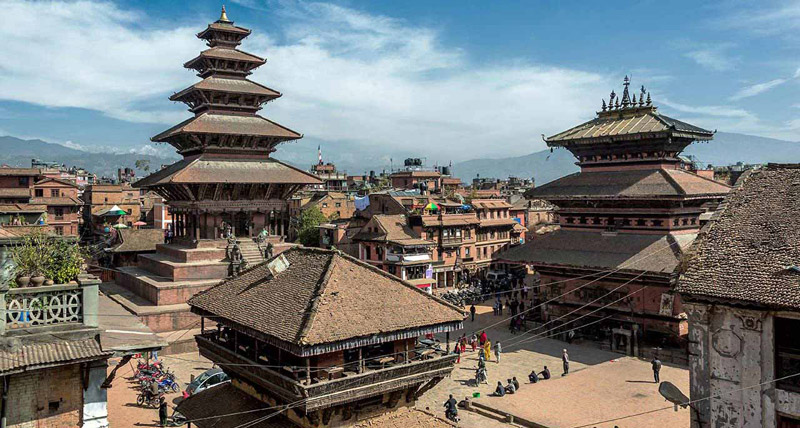
Bhaktapur, a small town about 10 kilometres from Kathmandu, is famous for its many varied temples. The most impressive is the five-storey Nyatapola Temple on Taumadhi Tole (pictured), the tallest temple in Nepal built in 1702 during the reign of King Bhupatindra Malla. Bhaktapur, which became an independent city-state under King Ananda Malla in the 12th century, also has its own Durbar Square (replete with a number of temples, including one featuring erotic cows, camels and elephants!).
The northern section of the square is home to the Royal Palace, with visitors able to access the Golden Gate, intricately carved and set into a bright red gatehouse, and the National Art Gallery, with an extensive collection of Tantric cloth paintings. But the town also has a timeless air, with visitors able to see grain laid out to dry in the sun, potters at work in Potters' square, locals weaving baskets, drying laundry or collecting water, and children playing. Keep an eye out for exquisite architecture as you wander the streets: many buildings feature intricately carved woodwork (such asthe famous Peacock window, on an alley leading south-east from the Tachupal Tole).
No cars are allowed inside the Bhaktapur town centre and, as a result, it is quiet by comparison to the country's capital. As a result, many travellers prefer to stay in Bhaktapur and take day trips to Kathmandu.
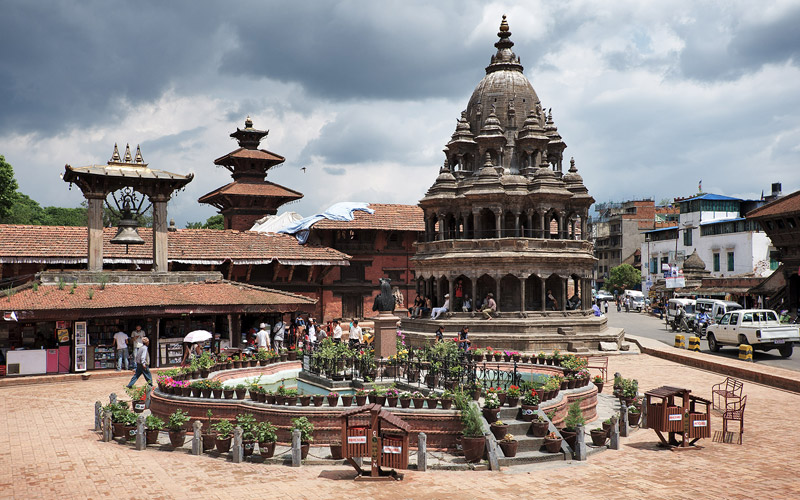
Patan is situated to the south of Kathmandu, and only separated from the capital by the Bagmati river. It is the second largest town in the Kathmandu valley. Patan has an ancient history, with the corners of the town being marked by stupas erected in around 250 BC. Research by Lonely Plant suggests that Patan has a greater concentration of temples per square metre than either Kathmandu or Bhaktapur! Patan's most interesting attractions include the Golden Temple (together with a number of tortoises found in its courtyard), the five-storey Kumbeshwar Temple (dating from 1392), and the Red Machhendranath Temple (dating from the 17th century, and containing carvings of a number of weird and wonderful animals). The Patan Museum is housed in a carefully restored Malla royal palace on Patan Darbar and exhibits about 200 examples of bronze or copper gilt statues of Buddhist or Hindu deities. Opened in 1997 by King Birendra, the building's 14-year restoration was funded by the Austrian government. Highlights include a 12th century seated Buddha, named Shakyamuni, made of copper alloy and gilt and the Museum's Keshav Narayan Chowk courtyard (complete with wood carvings, red-brick facade and golden door and window). The works are accompanied by helpful explanatory information, produced by the eminent cultural historian Mary S. Slusser. The Patan Museum Cafe, situated in the peaceful garden, offers good quality snacks and light meals.
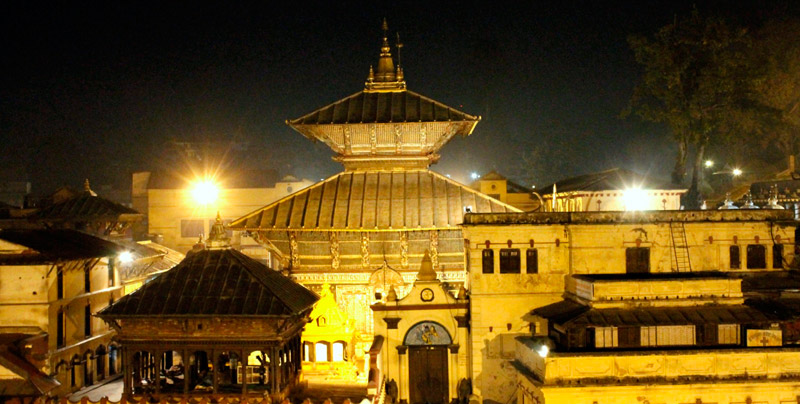
Built in 1696 on the orders of King Bhupendra Malla, Pashupatinath is Nepal's most important Hindu temple. Constructed in the pagoda style of architecture, Pashupatinath stands on the banks of the Bagmati river, has a distinctive gilded rooftop, intricately carved rafters (featuring members of Shiva's family) and four silver-plated main doors surrounded by statues of deities. Pashupatinath reaches a maximum height of 24 metres, and is presided over by piests called Bhattas and achief priest called Mool Bhatt or Raval. Non-Hindus are not allowed inside the temple, though a glimpse of Shiva's bull, Nandi, can be caught from outside the western entrance.
There is nonetheless much to see. The temple's exterior and its surrounding buildings are worth a look. Sadhus (Hindu holy men) watch the world go by. Traders hawk marigolds, incense and conch shells. And the riverbanks of the Bagmati river are a popular place for cremations. Whilst the 'ghats' in front of the temple were reserved for the cremation of royalty, four other ghats to the south of the nearby bridges are in regular use. There is often a cremation in progress, with a shrouded body lifted on top of a log fire with surprisingly little ceremony. Cremations are followed by ritual bathing in the river.
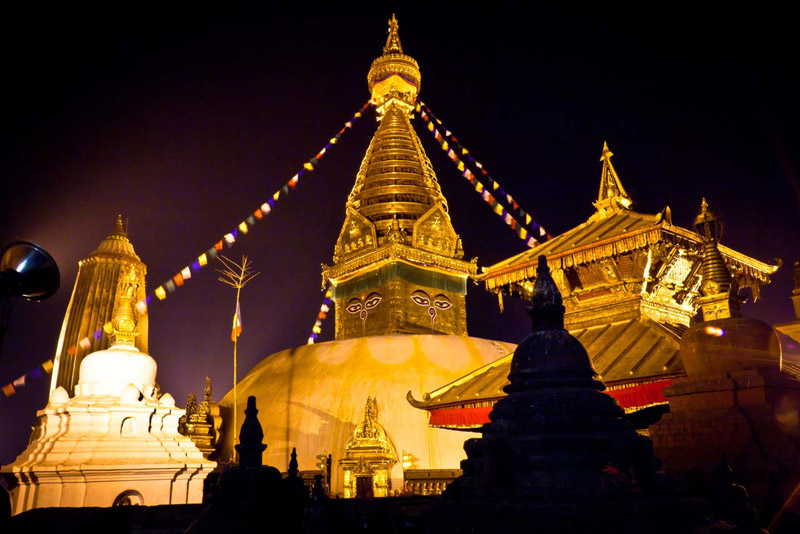
The Swayambhunath Stupa (meaning the ‘self-created’ stupa, aka the Monkey Temple) is found on a hilltop to the west of Kathmandu. Second in importance only to the Boudhanath Stupa, the Swayambhunath complex, founded by King Manadeva during the fifth century, contains a stupa, temples, shrines, Tibetan monastery, museum and library. The Stupa, re-gilded with 20 kilograms of gold in 2010, has a large white dome at its base, above which are painted four sets of Buddha’s eyes and eyebrow; further up the Stupa are found four pentagonal Toran (gateways) and thirteen tiers leading to the Stupa’s golden spire.
Monkeys live to the north-west of the complex; they are said to be holy because they grew out of head lice living in the bodhisattva (enlightened person) Manjusri’s long hair! Visitors should also inspect the carvings of the five Panch Buddhas found on each side of the Stupa, the two lions guarding the Stupa’s entrance, the adjacent Harati Devi Temple, Shantipur (a small temple northwest of the main stupa), and the Pratappur and Anantapur shrines.
We recommend accessing Swayambhunath by the 365 worn steps that lead up the eastern side of the hill; the start of this climb is marked by a 12-foot Tibetan prayer wheel and three painted Buddha statues. The Stupa offers great views over Kathmandu, especially in the early evening. To catch the Tibetan pilgrims, you will need to arrive before 9am.

The Kopan Monastery is a gated community of Buddhist monks found on a hilltop north of Boudhanath. Founded by Lamas Thubten Yeshe and Zopa Rinpoche in the early 1970s, the Monastery houses 360 monks in grounds which include an enormous Bodhi tree, the Chenrezig gompa (temple), statues, prayer wheels, prayer flags (at the top of Kopan Hill) and the colourful Thousand Buddha Relic Stupa (pictured).
The Monastery is twinned with the nearby Khachoe Ghakyil Nunnery. Those visiting should expect to replace the hubbub of central Kathmandu with morning chanting, an evening pooja/puja ceremony (involving pageantry and traditional Tibetan music made from cymbals and large horns), study, silence, peace and love. The Monastery also offers daily and longer courses in meditation and yoga, provides panoramic views over the Kathmandu valley, has an immaculately kept garden and great gift shop and café. Just beware of the monkeys: they have a habit of stealing ice-cream from unsuspecting tourists!
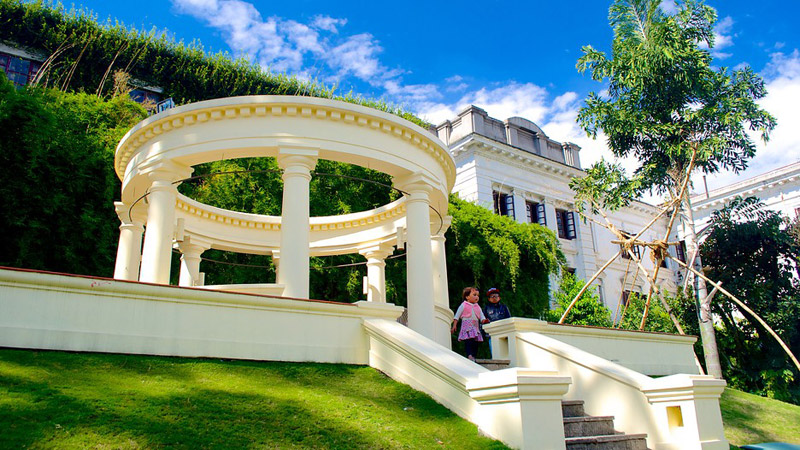
The Garden of Dreams is a beautiful enclave found a stone's throw from the centre of Thamel. The Garden—formal in style—occupies about half a hectare. Its lush lawns, sunken flower gardens, large central pond, fountains, gazebos and three neo-classical pavilions are kept in pristine condition. Built by Field Marshall Kaiser Shumsher (1892-1964), son of Nepal's prime minister Chandra Shumsher, the Garden was inspired after a trip to Edwardian England using funds that Kaiser had won from his father in a game of cowrie shells.
The Garden was restored by the Austrian team responsible for the renovation of the Patan Museum (see above). They are best savoured in good weather, over a picnic or whilst reading a book or surfing the net (wifi available).

Experience the Kathmandu Valley on a 3-day walk through forest and villages. Marvel at the panoramic mountain views from Nagarkot, including spectacular Mt. Everest. This is the perfect opportunity to explore the scenic area surrounding Kathmandu.
This Kathmandu Valley hiking trip is designed for those having only a few days in the area. You’ll start out from Sundarijal, which is about a 40-minute drive from Kathmandu. The hiking trail leads toward Nagarkot through Jhule village, where you’ll enjoy panoramic views of the Himalayas. The trail ends at Changu Narayan, listed as a UNESCO World Heritage Site and the oldest temple in the Kathmandu Valley, dating to the 5th century A.D. Twin-sharing accommodation and all meals are provided.
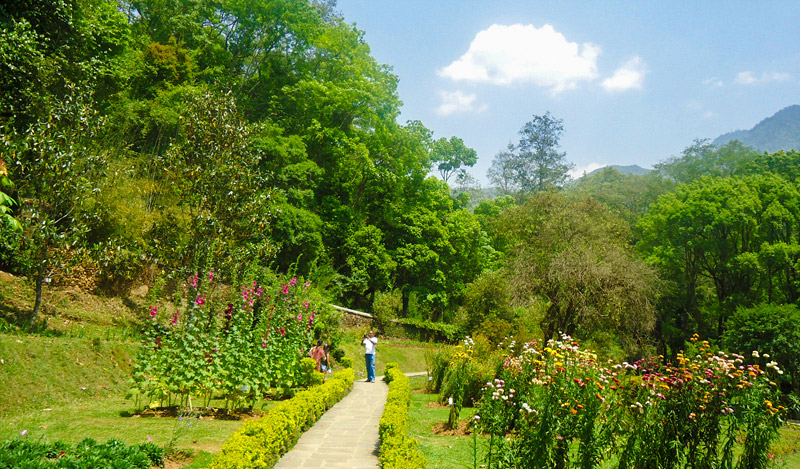
The Royal Botanical Gardens, found 18 kms south of Kathmandu in the foothills of Mount Phulchowki, are a site of outstanding beauty. Opened by King Mahendra Bir Bikram Shah Dev in 1962, the Botanical Gardens—the only in Nepal—now hold over 500 species of plant in 82 hectares. Highlights include the decorative Coronation Pond, visitor centre (with interesting exhibits on Nepal's flora), greenhouses, and collections of rhododendrons (Nepal's national flower), lilies, orchids, cacti and ferns. Spring and autumn are the peak flowering seasons and therefore the best times to visit.
The Godavari Spring, found 200 metres from the Botanical Gardens' main gate, is also well worth a look. This freshwater spring spouting ice-cold water from the Gadavari river is reputed to have been created when the Buddhist Mystic Padmasambhava struck a rock (in order to demonstrate that the ultimate truth is clear and will fulfill the people's thirst); unsurprisingly, the Spring is a popular Hindu and Buddhist pilgrimage site. Those with more energy will enjoy a hike to the top of Phulchowki (2715 m), the highest hill in the Kathmandu valley, to take in the views and a small Buddhist shrine at the summit.
If you want to find out more about things to do, major places to visit in Nepal or need our assistance for planning your Nepal holiday, simply send us an email and we will get back to you right away.